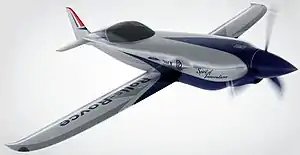Rolls-Royce ACCEL
The Rolls-Royce ACCEL (Accelerating the Electrification of Flight) is an electric aircraft demonstrator developed by Rolls-Royce plc.
| ACCEL | |
|---|---|
 | |
| Role | electric aircraft testbed |
| National origin | United Kingdom |
| Manufacturer | Rolls-Royce plc |
| First flight | planned 2020[1] |
| Status | In development |
| Developed from | Sharp Nemesis NXT[2] |
Development
Rolls-Royce is developing a racing aircraft, intended to fly in 2020, to gain the all-electric air speed record, targeting over 480 km/h (260 kn). Designed at Gloucestershire Airport, the project is partly funded by the UK government and involves partners such as electric motor and controller manufacturer YASA Limited and aviation start-up Electroflight.[1]
The electric aircraft record is 182 kn (337 km/h), set in 2017 by a Siemens powered Extra 330. The team refers to the 1931 Schneider Trophy won by a R-R-powered Supermarine S.6B, reaching 298 kn (552 km/h).[2]
Design
The 24 ft (7.3 m) span aircraft is powered by three high power density electric motors driving a single three-blade propeller spinning at 2,400 RPM, designed and manufactured by YASA, running at 750 volts and delivering over 500 hp (370 kW) combined. Its 6,000-cell, cooled battery pack should have the highest energy density for an aircraft and should allow a 320 km; 170 nmi range.[1]
It is derived from the carbonfibre Sharp Nemesis NXT racer, cruising at 282 kn (522 km/h) with a 350hp (260kW) piston engine, but reaching 355 kn (657 km/h) with a highly tuned engine. Battery power output will be 500 hp (373 kW) continuous, reaching 750kW (1,006hp) at maximum power. The battery, motors and control equipment weigh the same as the regular engine and fuel tank while the NXT has a maximum take-off weight of 1,200kg (2,645lb).[2]
References
- "Introducing ACCEL". Rolls-Royce Plc. 2 Jan 2019.
- Michael Gubisch (9 Jan 2019). "Rolls-Royce aims to break speed record with electric single-seater". Flightglobal.